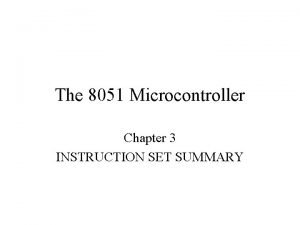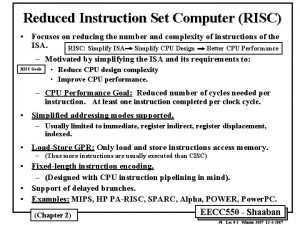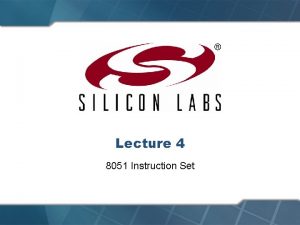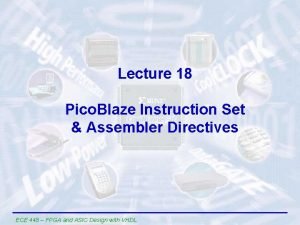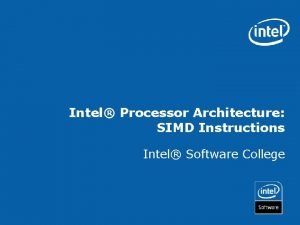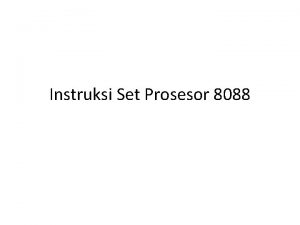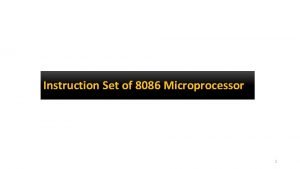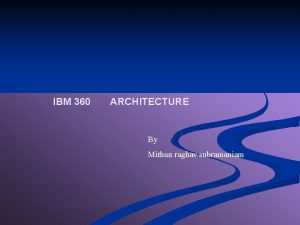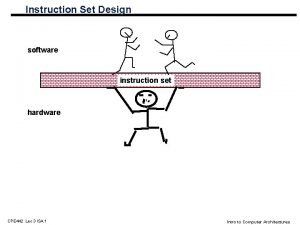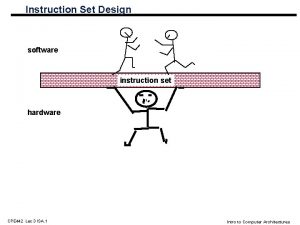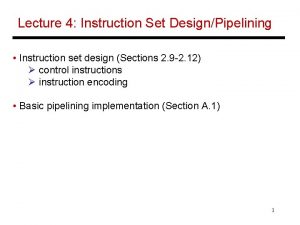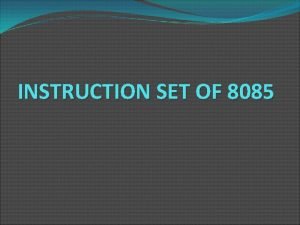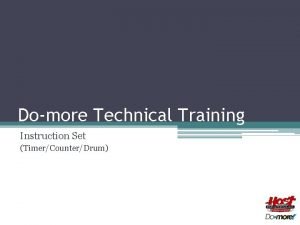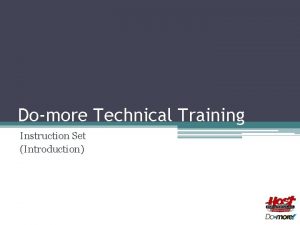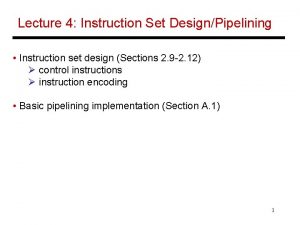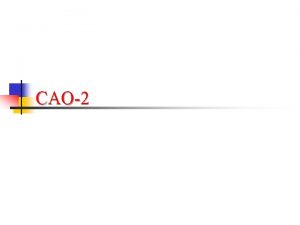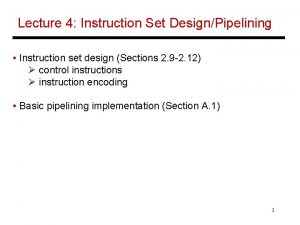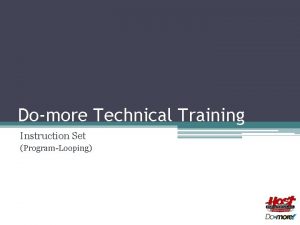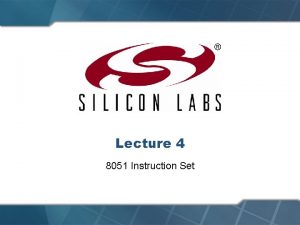Chapter 4 Instruction Set 1 Instruction Set Overview































- Slides: 31

Chapter 4 Instruction Set 1

Instruction Set Overview Ø PIC 18 F 4520 devices incorporate the standard set of: § 75 PIC 18 core instructions, § 8 extended set of instructions, for the optimization of code 2

Standard Instruction Set Ø The standard PIC 18 instruction set are : § a single program memory word (16 bits), and § four instructions that require two program memory locations. Ø Each single-word instruction is a 16 -bit word divided into: § an opcode, which specifies the instruction type and § one or more operands, which further specify the operation of the instruction. 3

Standard Instruction Set Ø The instruction set is grouped into four basic categories: § Byte-oriented operations § Bit-oriented operations § Literal operations § Control operations 4

Ø Byte-oriented operations Most Byte-oriented instructions have three operands: § The file register (specified by ‘f’) § The destination of the result (specified by ‘d’) § The accessed memory (specified by ‘a’) Ø ‘f’ specifies which file register is to be used by the instruction. Ø ‘d’ specifies where the result of the operation is to be placed. § If ‘d’ is zero, the result is placed in the WREG register. § If ‘d’ is one, the result is placed in the file register specified in the instruction. 5

Bit-oriented operations Ø All Bit-oriented instructions have three operands: § The file register (specified by ‘f’) § The bit in the file register (specified by ‘b’) § The accessed memory (specified by ‘a’) Ø ‘b’ selects the number of the bit affected by the operation Ø ‘f’ represents the number of the file in which bit is located. 6

Literal operations Ø The Literal instructions may use some of the following operands: § A literal value to be loaded into a file register (specified by ‘k’). § The desired FSR register to load the literal value into (specified by ‘f’). § No operand required (specified by ‘—’) 7

Control operations Ø The Control instructions may use some of the following operands: § A program memory address (specified by ‘n’) § The mode of the CALL or RETURN instructions (specified by ‘s’) § The mode of the table read and table write instructions (specified by ‘m’) § No operand required (specified by ‘—’) 8

Standard Instruction Set Ø All instructions are a single word(16 bits), except for four double-word instructions. § These double-word instructions were made to contain the required information in 32 bits. § In the second word, the 4 MSBs are ‘ 1’s, if this second word is executed as an instruction (by itself), it will be execute as a NOP. 9

Standard Instruction Set Ø All single-word instructions are executed in a single instruction cycle, unless § a conditional test is true or the program counter is changed as a result of the instruction. § In these cases, the execution takes two instruction cycles, with the additional instruction cycle(s) executed as a NOP. Ø The double-word instructions execute in two instruction cycles. Ø One instruction cycle consists of four oscillator periods. 10

Oscillator Frequency Ø For an oscillator frequency of 4 MHz, the normal instruction execution time is 1 μs. Ø If a conditional test is true, or the program counter is changed as a result of an instruction, the instruction execution time is 2 μs. Ø Two-word branch instructions (if true) would take 3 μs. 11

Byte-oriented file register operations ADDWF MYREG, W, B 15 OPCODE 10 9 8 d a 7 0 f (FILE #) d = 0 for result destination to be WREG register d = 1 for result destination to be file register (f) a = 0 to force Access Bank a = 1 for BSR to select bank f = 8 -bit file register address 12

Byte to Byte move operations (2 -word) MOVFF MYREG 1, MYREG 2 15 12 OPCODE 15 1111 11 0 f (Source FILE #) 12 11 0 f (Destination FILE #) f = 12 -bit file register address 13

Bit-oriented file register operations BSF MYREG, bit, B 15 12 11 OPCODE 9 b (bit #) 8 7 a 0 f (FILE #) b = 3 -bit position of bit in file register (f) a = 0 to force Access Bank a = 1 for BSR to select bank f = 8 -bit file register address 14

Literal operations MOVLW 7 Fh 15 8 7 OPCODE 0 k (literal) k = 8 -bit immediate value 15

Control operations GOTO operations 15 8 7 OPCODE 15 0 n<7: 0> (literal) 12 11 1111 n<19: 8> (literal) GOTO Label 0 GOTO Label n = 20 -bit immediate value 16

Control operations CALL operations 15 8 OPCODE 15 0 n<7: 0> (literal) 12 1111 7 11 GOTO Label 0 n<19: 8> (literal) CALL MYFUNC S = Fast bit 17

Control operations Branch operations 15 11 1111 15 0 n<10: 0> (literal) 8 OPCODE 10 7 BRA MYFUNC 0 n<7: 8> (literal) BC MYFUNC 18

Instruction Flow / Pipelining Ø An “Instruction Cycle” consists of four Q cycles: Q 1 through Q 4. Ø The instruction fetch and execute are pipelined in such a manner that: § a fetch takes one instruction cycle, § while decode and execute take another instruction cycle. Ø due to pipelining, each instruction effectively executes in one cycle. Ø If an instruction causes the program counter to change (e. g. , GOTO), then two cycles are required to complete the instruction. 19

Instruction Flow / Pipelining 20

Instruction Flow / Pipelining Ø A fetch cycle begins with the Program Counter incrementing in Q 1. Ø In the execution cycle, the fetched instruction is latched into the Instruction Register (IR) in Q 1 cycle. Ø This instruction is then decoded and executed during the Q 2, Q 3 and Q 4 cycles. Ø Data memory is read during Q 2 (operand read) and written during Q 4 (destination write) 21

Instructions in Program Memory Ø The program memory is addressed in bytes. Ø Instructions are stored as two bytes or four bytes in program memory. Ø The Least Significant Byte of an instruction word is always stored in a program memory location with an even address (LSB = 0). Ø To maintain alignment with instruction boundaries, the PC increments in steps of 2 and the LSB will always read ‘ 0’. 22

Instructions in Program Memory 23

Two-Word (four bytes) Instruction Ø The standard PIC 18 instruction set has 4 two-word instructions: § § Ø CALL MOVFF GOTO LSFR. The entire data memory may be accessed by : § Direct, § Indirect or § Indexed Addressing modes. 24

Two-Word (four bytes) Instruction 25

Data Addressing Modes Ø The addressing modes are: § § Ø Inherent Literal Direct Indirect An additional addressing mode, Indexed Literal Offset, is available when the extended instruction set is enabled (XINST Configuration bit = 1). 26

Inherent Addressing Ø Do not need any argument at all Ø They either perform an operation that globally affects the device or they operate implicitly on one register. Ø Examples include SLEEP, RESET and DAW. 27

Literal Addressing Ø Require an additional explicit argument in the opcode. Ø They require some literal value as an argument. Ø Examples are ADDLW and MOVLW, which, add or move a literal value to the W register. Ø CALL and GOTO, which include a 20 -bit program memory address. 28

Direct Addressing Ø Specifies all or part of the source and/or destination address of the operation within the opcode itself. Ø Bit-oriented and Byte oriented instructions use some version of Direct Addressing by default. Ø The address specifies a register address in one of the banks of data RAM or a location in the Access Bank as the data source for the instruction. Ø The Access RAM bit ‘a’ determines how the address is interpreted. 29

Indirect Addressing Ø Allows the user to access a location in data memory without giving a fixed address in the instruction. Ø This is done by using File Select Registers (FSRs) as pointers to the locations to be read or written to. Ø Since the FSRs are themselves located in RAM as Special Function Registers, they can also be directly manipulated under program control. Ø This makes FSRs very useful in implementing data structures, such as tables and arrays in data memory. 30

Indirect Addressing Example 5 -5: How to clear RAM (BANK 1) using Indirect Addressing LFSR 0, 100 h ; NEXT CLRF POSTINC 0 ; Clear IND register then inc ptr BTFSS FSR 0 H, 1 ; All done with ; Bank 1? BRA NEXT ; NO, clear next CONTINUE ; YES, continue 31
 Total set awareness set consideration set
Total set awareness set consideration set Training set validation set test set
Training set validation set test set Individualized instruction vs differentiated instruction
Individualized instruction vs differentiated instruction What is direct instruction strategy
What is direct instruction strategy Chapter 24 trauma overview
Chapter 24 trauma overview Emt chapter 14 medical overview
Emt chapter 14 medical overview Chapter 9 lesson 2 photosynthesis an overview
Chapter 9 lesson 2 photosynthesis an overview Chapter 12 selling overview
Chapter 12 selling overview Financial intermediaries
Financial intermediaries Chapter 1 overview of verb tenses
Chapter 1 overview of verb tenses Overview of personal finance chapter 1
Overview of personal finance chapter 1 Overview of the dentitions chapter 11
Overview of the dentitions chapter 11 Chapter 1 introduction to personal finance
Chapter 1 introduction to personal finance Chapter 32 an overview of animal diversity
Chapter 32 an overview of animal diversity Chapter 1 an overview of financial management
Chapter 1 an overview of financial management Chapter 17 overview elements and their properties
Chapter 17 overview elements and their properties Chapter 1 overview of financial statement analysis
Chapter 1 overview of financial statement analysis Ax 86s
Ax 86s Little man machine
Little man machine Instruction set of 8051
Instruction set of 8051 Addressing modes of sic
Addressing modes of sic Format instruksi 3 alamat
Format instruksi 3 alamat Risc instruction set example
Risc instruction set example Marie computer architecture
Marie computer architecture Cjne instruction in 8051 example
Cjne instruction in 8051 example Assembly language
Assembly language Intel simd instruction set
Intel simd instruction set 8088 instruction set
8088 instruction set Instruction set of 8086 microprocessor
Instruction set of 8086 microprocessor Classify instruction set of 8086
Classify instruction set of 8086 Isa architecture
Isa architecture Ibm 360 machine structure
Ibm 360 machine structure



















